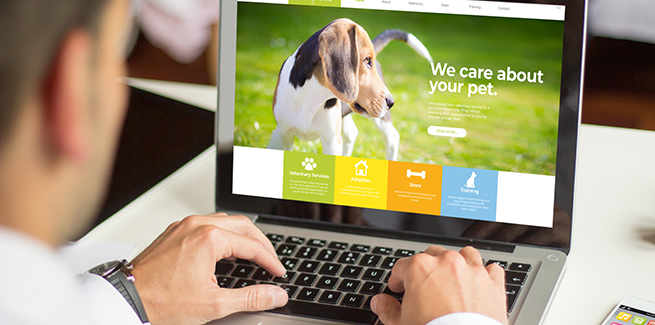How to involve your staff in telehealth

The entire veterinary profession has been grappling with the challenges of implementing telehealth in their daily practices as the need for remote care has increased during the COVID pandemic. Chances are good that you are already using some form of telehealth without realizing it—and now is the time to further harness it to bond with clients, engage staff, and improve patients’ healthcare. If you weren’t prepared for the COVID-19 pandemic, there’s no time like the present to upgrade your client service and patient care using telehealth.
One frequent pain point I’ve encountered is that veterinarians are feeling overwhelmed with the need to juggle their in-hospital work schedule in addition to fielding the phone calls, texts, and social media messages that flood in nonstop. One solution to this problem is to engage your practice’s staff in your telehealth services, not only to better distribute the telehealth workload but also to more fully utilize your team’s skills and abilities in the implementation of telehealth. Many support staff members can use telehealth and communicate with clients under the direction of a veterinarian (within the bounds of state and federal laws).
Here are some easy and practical tips for getting your staff involved in your practice’s telehealth services.
Involve veterinary technicians and client service representatives in basic triage
Before a client schedules a curbside appointment with your practice, have them use telehealth services to find out whether their pet needs to come in for care or if a telehealth appointment will suffice. Your client service representatives and technicians can both help to triage patients and schedule appropriate appointments. Skilled technicians can also handle basic triage services with maximum efficiency since they will not need to communicate every query to the veterinarians on staff. Train your staff to triage incoming patients through telehealth and to loop in veterinarians when needed to determine the best care for the pet.
Share telehealth appointments with your technicians
Implementing virtual appointments with your technicians is a perfect way to extend your telehealth offerings. Following your state’s laws about the kind of appointments a technician can cover, think about what part of the patient’s appointment can be delegated to the technician, just as you would in the hospital. For example, delegate educational items to your technicians, such as how to housetrain a new puppy or how to get a new cat to use a scratching post. They can help educate clients about pet nutrition or even train a client on how to administer subcutaneous fluids. These kinds of telehealth services could be included after a veterinarian has concluded a virtual exam or as a follow-up option for the client after a treatment plan has been recommended. Clients can schedule telehealth follow-up appointments after the initial visit to get additional questions answered, receive reminders, or double-check the veterinarian’s instructions.
Have staff handle house calls to enhance your telehealth care
At certain times and with certain patients, you need information that requires hands-on care. For many rural clients, however, coming in for curbside service isn’t feasible. Many chronically ill patients who need daily or weekly care cannot come to the practice, either. If the veterinarian-client-patient relationship is already established, have staff make house or farm calls and relay information that would normally only be possible with in-person visits. For example, a technician might travel to a rural client to collect vitals and potentially capture heart and lung sounds with a digital stethoscope. This may also be helpful for follow-up appointments, such as chronic wound care. A technician can check in on a patient and replace bandages for a client who is not able to come into the hospital on a frequent basis. This process can help increase touchpoints between a client and the veterinary practice, and the information is relayed in real time to the veterinarian, who maintains responsibility for overseeing the next steps in the patient’s care.
Regardless of how your staff is involved in the telehealth care in your practice, be sure you factor in staff time when you consider what to charge for your services.
Is your hospital still struggling to implement telemedicine? Come join me at the 2020 virtual Connexity conference, where I’ll be leading a session to decode the barriers and sharing actionable, practical tips on starting a thriving telehealth arm for your practice.
Learn more about the 2020 virtual and on-demand Connexity conference.
About the author
Lori M. Teller, DVM, DABVP (Canine/Feline), CVJ, is a graduate of Texas A&M University College of Veterinary Medicine and Biomedical Sciences (TAMU CVM) and a board-certified diplomate of the American Board of Veterinary Practitioners in canine and feline practice. She has worked at Meyerland Animal Clinic for many years, starting at age 12, and has earned many awards in addition to serving on numerous boards of trustees, task forces, and committees. Since 2018, she has been the clinical associate professor of telehealth at TAMU CVM, where her team has recently received grants from the United States Department of Agriculture and Texas A&M’s School of Innovation. Outside the veterinary world, Teller is a founder and trustee for The Gateway Academy, a high school for students with learning differences and special needs. She married her high school sweetheart, Dr. Craig Teller. They have one son and several pets. She is leading the Telehealth 2.0: Beyond the VCPR and How to Integrate It Into Your Practice Tomorrow session at the 2020 virtual Connexity conference.
Photo credit: © Gettyimages/milindri



